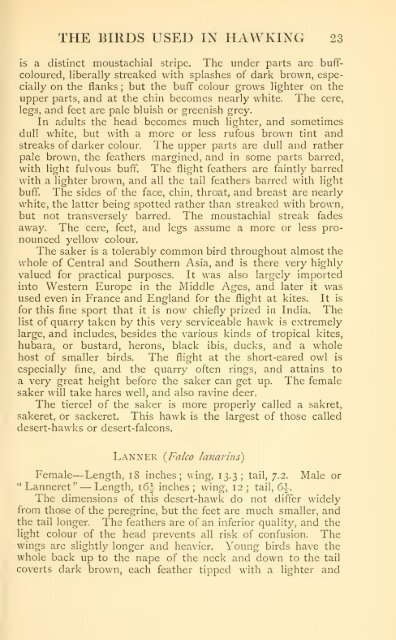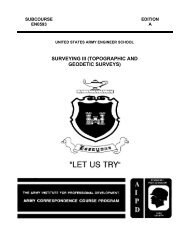The art and practice of hawking - Modern Prepper
The art and practice of hawking - Modern Prepper
The art and practice of hawking - Modern Prepper
- No tags were found...
You also want an ePaper? Increase the reach of your titles
YUMPU automatically turns print PDFs into web optimized ePapers that Google loves.
THE BIRDS USED IN HAWKING 23<br />
is a distinct moustachial stripe. <strong>The</strong> under p<strong>art</strong>s are buffcoloured,<br />
liberally streaked with splashes <strong>of</strong> dark brown, especially<br />
on the flanks ; but the buff colour grows lighter on the<br />
upper p<strong>art</strong>s, <strong>and</strong> at the chin becomes nearly white. <strong>The</strong> cere,<br />
legs, <strong>and</strong> feet are pale bluish or greenish grey.<br />
In adults the head becomes much lighter, <strong>and</strong> sometimes<br />
dull white, but with a more or less rufous brown tint <strong>and</strong><br />
streaks <strong>of</strong> darker colour. <strong>The</strong> upper p<strong>art</strong>s are dull <strong>and</strong> rather<br />
pale brown, the feathers margined, <strong>and</strong> in some p<strong>art</strong>s barred,<br />
with light fulvous buff. <strong>The</strong> flight feathers are faintly barred<br />
with a lighter brown, <strong>and</strong> all the tail feathers barred with light<br />
buff <strong>The</strong> sides <strong>of</strong> the face, chin, throat, <strong>and</strong> breast are nearly<br />
white, the latter being spotted rather than streaked with brown,<br />
but not transversely barred. <strong>The</strong> moustachial streak fades<br />
away. <strong>The</strong> cere, feet, <strong>and</strong> legs assume a more or less pronounced<br />
yellow colour.<br />
<strong>The</strong> saker is a tolerably common bird throughout almost the<br />
whole <strong>of</strong> Central <strong>and</strong> Southern Asia, <strong>and</strong> is there very highly<br />
valued for practical purposes. It was also largely imported<br />
into Western Europe in the Middle Ages, <strong>and</strong> later it was<br />
used even in France <strong>and</strong> Engl<strong>and</strong> for the flight at kites. It is<br />
for this fine sport that it is now chiefly prized in India. <strong>The</strong><br />
list <strong>of</strong> quarry taken by this very serviceable hawk is extremely<br />
large, <strong>and</strong> includes, besides the various kinds <strong>of</strong> tropical kites,<br />
hubara, or bustard, herons, black ibis, ducks, <strong>and</strong> a whole<br />
host <strong>of</strong> smaller birds. <strong>The</strong> flight at the short-eared owl is<br />
especially fine, <strong>and</strong> the quarry <strong>of</strong>ten rings, <strong>and</strong> attains to<br />
a very great height before the saker can get up. <strong>The</strong> female<br />
saker will take hares well, <strong>and</strong> also ravine deer.<br />
<strong>The</strong> tiercel <strong>of</strong> the saker is more properly called a sakret,<br />
sakeret, or sackeret. This hawk is the largest <strong>of</strong> those called<br />
desert-hawks or desert-falcons.<br />
Lanner {Falco lanarius)<br />
Female— Length, i8 inches; wing, 13.3; tail, 7.2. Male or<br />
"Lanneret" — Length, i6i inches ;<br />
wing, 12; tail, 6|-.<br />
<strong>The</strong> dimensions <strong>of</strong> this desert-hawk do not differ widely<br />
from those <strong>of</strong> the peregrine, but the feet are much smaller, <strong>and</strong><br />
the tail longer. <strong>The</strong> feathers are <strong>of</strong> an inferior quality, <strong>and</strong> the<br />
light colour <strong>of</strong> the head prevents all risk <strong>of</strong> confusion. <strong>The</strong><br />
wings are slightly longer <strong>and</strong> heavier. Young birds have the<br />
whole back up to the nape <strong>of</strong> the neck <strong>and</strong> down to the tail<br />
coverts dark brown, each feather tipped with a lighter <strong>and</strong>

















